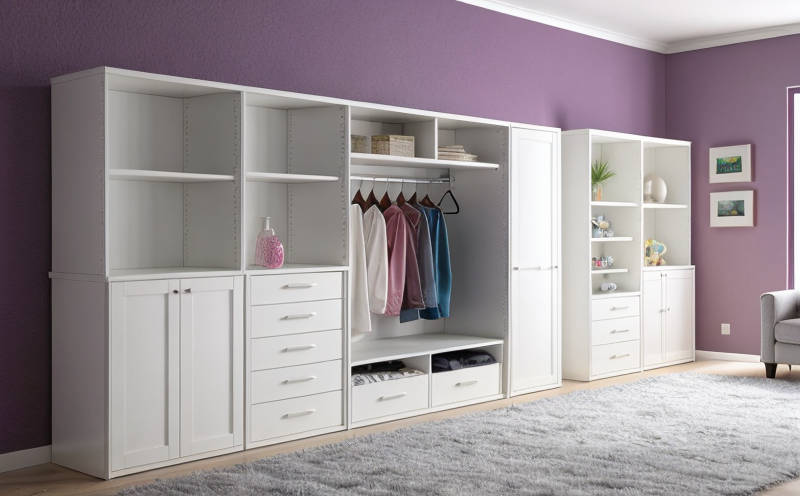ASTM D6007 Formaldehyde Emission Testing for Storage Furniture Materials
The ASTM D6007 standard test method is widely utilized in the furniture industry to measure formaldehyde emissions from materials used in storage furniture. This stringent testing ensures compliance with regulatory standards and enhances product safety, especially in environments where prolonged human exposure could occur.
Formaldehyde is a colorless gas that has been identified as a potential carcinogen by various health organizations. In the context of furniture manufacturing, formaldehyde can be found in finishes, adhesives, and other materials used to construct storage furniture such as wardrobes, filing cabinets, and office desks.
The ASTM D6007 test method provides a reliable means of quantifying the amount of formaldehyde released into the air from these materials over a 48-hour period. This is particularly important for compliance with regulations like the California Air Resources Board's (CARB) Rule 972, which sets limits on allowable emissions levels.
The test involves placing samples of storage furniture materials in a climate-controlled chamber where conditions are held constant at 23°C and 50% relative humidity. The sample is then exposed to air for 48 hours, during which time the formaldehyde concentration is continuously monitored by an electrochemical sensor. After this period, the total amount of formaldehyde released from the material is calculated based on the cumulative emissions recorded.
The results are reported in parts per million (ppm) and used to determine compliance with relevant standards or internal quality control targets. This information is crucial for manufacturers aiming to meet consumer expectations regarding indoor air quality and health safety.
Scope and Methodology
The ASTM D6007 test method covers the determination of formaldehyde emissions from solid wood, veneer, particleboard, medium-density fiberboard (MDF), hardboard, and other similar materials commonly used in storage furniture. The methodology is designed to simulate real-world conditions under which these materials are likely to be exposed to air.
The test chamber used for ASTM D6007 must meet specific dimensions and environmental controls specified by the standard. It should have a volume of 1,450 liters (about 51 cubic feet) with internal dimensions of approximately 38 x 29 x 42 cm (15 x 11.4 x 16.5 inches).
The test requires careful preparation and handling of the samples. Specimens are typically cut to a standard size of 10 x 10 x 2 cm (about 3.9 x 3.9 x 0.8 inches) for consistency across different tests. Multiple replicates may be necessary depending on the variability expected in the material.
After placing the samples into the test chamber, a fan circulates air through the chamber to ensure even exposure of formaldehyde vapor throughout. The testing process lasts exactly 48 hours, during which continuous measurements are taken every hour using an electrochemical sensor.
Benefits
- Enhanced Product Safety: Ensures that products meet stringent emission standards and contribute to healthier indoor environments.
- Avoidance of Regulatory Penalties: Helps manufacturers stay compliant with local regulations such as CARB Rule 972, avoiding costly fines or product recalls.
- Increased Consumer Confidence: Builds trust among consumers who are increasingly concerned about the quality and safety of household products.
- Improved Quality Control: Provides actionable data for continuous improvement in manufacturing processes and material selection.
Use Cases and Application Examples
- Compliance Audits: Many jurisdictions require formaldehyde testing as part of regular compliance audits. ASTM D6007 is the standard test method accepted by these authorities.
- New Product Development: R&D teams use this test to evaluate new materials and formulations for their potential impact on indoor air quality.
- Supply Chain Management: Procurement departments can use ASTM D6007 results to verify that suppliers meet specified emission limits, ensuring consistency across the supply chain.





